Any kitchen should correspond to its purpose, that is, be comfortable, beautiful and functional. To create a comfortable interior, not every user is ready to spend a lot of money on the purchase of equipment and furniture. A natural stone sink will cost a property owner a significant amount of money. A way out of this situation will be a sink made of artificial stone for the kitchen. In the article, we will get acquainted with the nuances of choice, as well as the pros and cons of using such a product.
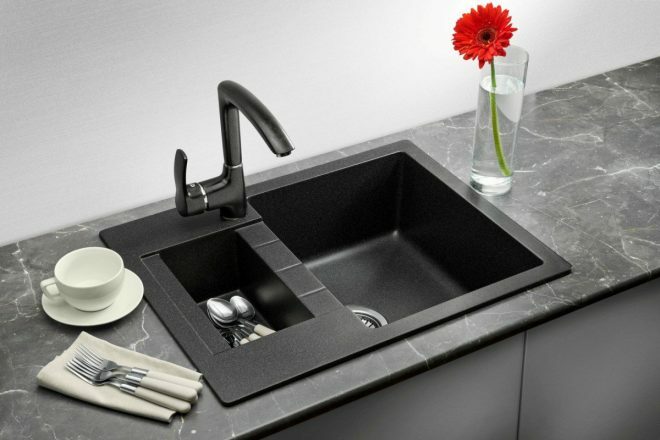
Material features
The material under consideration contains several components:
Attention! Earned on our website kitchen designer. You can familiarize yourself with it and design your dream kitchen for free! May also come in handy wardrobes designer.
- A piece of marble, particles of quartz or granite.
- Polymer binder.
- Pigment dye of the required color. Its presence in the composition allows you to give the sink shades of natural stone.
This composition contains granules of real stone, which gives reason to talk about the naturalness of the products. An acrylic sink is considered completely artificial, because it contains aluminum hydroxide, acrylic resins, as well as polymethylmeracrylate. The strength of the entire structure depends on the proportion of the last element in the base composition. Some users write reviews that the bottom of acrylic sinks falls off after several years of operation. This suggests that the manufacturer has added a minimum amount of the most expensive component of polymethylmeracrylate to the composition.
To protect against an aggressive external environment, the stone sink for the kitchen is covered with a special protective solution called gelcoat. This substance blocks pores where dirt, moisture and unpleasant odors can accumulate. On the surface of some models of sinks, special antibacterial preparations are applied. This layer protects the product from pathogens throughout the entire operational period.
Advantages and disadvantages
Before buying a stone sink for your kitchen, you need to familiarize yourself with its strengths and weaknesses. Let's start with the advantages of the material:
- Good resistance to aggressive environments. The surface of the products withstands contact with chemical solutions, but is afraid of abrasive substances (this does not apply to all models).
- Sufficient indicators of moisture resistance. Thanks to the protective layer, the material does not absorb water into the pores.
- Water from the tap, when it hits the stone, does not create the noise inherent in stainless steel products.
- Untreated liquid stains do not form on the sink.
- The material can withstand temperatures ranging from 180-280 degrees.
- Lack of unpleasant odors.
- A huge number of color models.
- Possibility of making sinks according to the given overall dimensions.
- Long period of operation.
- The possibility of carrying out repairs in case of minor surface damage.
The main disadvantages of kitchen sinks made of artificial stone are considered to be the high price, as well as a significant mass of products. The price of stainless steel analogues is much lower. The disadvantages also include the instability of some models to sudden temperature fluctuations, the possibility of cracks on the surface of monolithic products that are combined with the countertop.
Embedded models are considered a more promising option than combined structures, so many users prefer the first products. If there is a need to combine the countertop with the sink, then they must be made of the same materials, but the details must be independent. If there are chips and cracks on one part, there is no need to replace the other.

How to choose the right sink
In order for the sink to serve as long as possible, it is necessary to learn how to choose and operate it correctly. In this case, the area of the kitchen is taken into account, the amount of dishes that will be washed. Another important criterion is the cost of the model.
What is an artificial stone
The strength of the sink, its stability and other technical characteristics will depend on the composition of the material. The best proportions of stone chips and polymer binders are considered to be 80:20. The maximum strength is observed in shells made of granite chips. No marks remain on the surface of such products after exposure to abrasives. Quartz models have similar properties to granite parts. At the same time, marble sinks are quite capricious, they are afraid of scratches, with small mechanical stress, chips form on the surface.
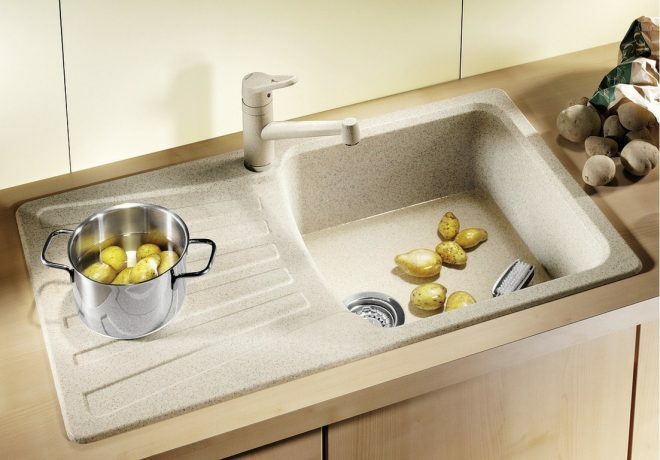
Shape and size
Sizes of artificial stone kitchen sinks may vary. A large washbasin offers convenience, functionality and luxury, but such a product is suitable for spacious rooms. When installing a sink in a small kitchen, it is recommended to select narrow, shallow products of a round or square shape. To save space in a small room, you can install a corner sink.
The main parameters of the products do not matter if they are installed in a spacious kitchen. In most models, the bowl is made in the shape of a circle; rectangle and oval are considered other popular options. Some materials for the corner parts of the room are made in the shape of a trapezoid. In spacious rooms, sinks with wings can be installed, here you can put dishes for drying. If you are using two bowls, a small container can be used to store various food items for defrosting or vegetables to be washed.
If a special machine is provided for washing dishes, then the sink is used only for rinsing cutlery, cups and bowls. When washing dishes by hand with 3 or more occupants, choose a wide and deep sink. A sufficient number of cutlery will fit in such a container.

Number of bowls
Large shells can be split into two or three bowls. The choice of such a model is justified only if the hostess cooks a lot. In this case, one bowl will be used for folding dishes, another for preparing and cleaning food, and another for defrosting. Such options are relevant for restaurants and cafes, as well as apartments where many residents live.
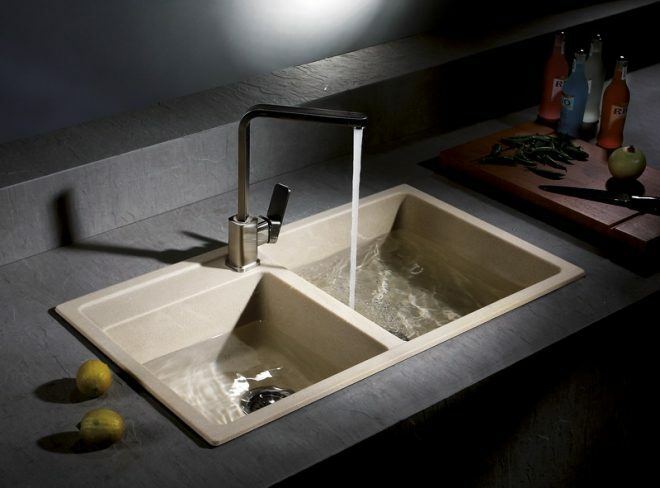
Color
Most of the models of sinks in the kitchen are matte, but there are products with a surface that imitate metal. The color of the kitchen sink should be as close to natural stone as possible. The range of such products contains 8-12 shades, but some manufacturers reduce the palette to 4-6 colors.
The most popular shades are:
- anthocyanin, chocolate color;
- white and beige shades;
- grey colour.
When purchasing a sanitary appliance, make sure that the color of the product matches the overall interior of the room.

Price
The price of sinks is in the range of 3-8 thousand rubles. It all depends on the composition and dimensions. Foreign models differ in a wide range of prices from 5 to 100 thousand. The most expensive are considered to be large, complex-shaped shells consisting of several bowls.
The best option for an apartment will be a product that costs 12-20 thousand rubles. Models cheaper than the specified price range are available from unscrupulous manufacturers. Such firms save on binders that provide the strength characteristics of the product. If improperly handled, cracks and chips appear on the surface of the material. In addition, ugly stains can form on low-quality sinks. They form when the surface comes into contact with hot objects.
Accessories
To extend the life of the sink, you need to purchase special accessories that will protect the stone from mechanical damage. Such protection is especially needed in cheap models with reduced technical characteristics.
To prevent cracks and chips, a basket is installed in the sink. Such a detail will prevent the destruction of the surface from an accidentally dropped object. The basket can be used for washing fruits and vegetables. Special coasters for hot dishes will help prevent the appearance of age spots.
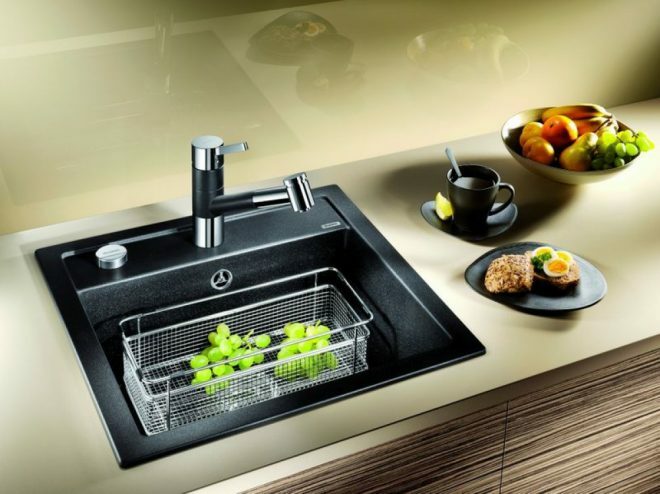
Manufacturer
the most popular brands of kitchen sinks are:
- German manufacturer Blanco, which supplies silgranite models to the market.
- Schock (Germany) makes crystalite shells.
- Franke (Germany) uses fragranite as the main raw material.
- The French manufacturer Benthor Corporation uses novoquartz or kermat for the manufacture of shells.
All of these raw materials (tegranite, crystalite, silgranite and fragranite) differ little from each other. The composition of the main components in the products remains unchanged, 80% is accounted for by stone chips, the remaining 20% is accounted for by binders.
The main difference between the products of various foreign companies is considered to be its own patented production technology. Distinctive features are present in materials such as novoquartz and kermat. The raw materials here include binders, acrylic, rubber, and fiberglass. It is necessary to understand that a high-quality sink will have an appropriate cost, therefore, when selecting sinks, give preference to well-known manufacturers who were able to collect positive reviews consumers.
Installation nuances
The installation of artificial stone sinks should be carried out by specially trained personnel. This is due to the fact that the products must be installed in a worktop made of the same material, and this causes certain difficulties. Unlike the average user, the experts will do the job in such a way that the gap between the work surface and the sink remains masked. With self-installation, this is unlikely to be achieved.
The installation of a stone sink in an ordinary countertop can be carried out independently, but the master must follow the instructions. At the initial stage of work, it is necessary to cut a hole for the dimensions of the sink. Standard overhead sinks have a size of 60 * 60 centimeters. In this case, the user must draw the outline of the model on cardboard and transfer it to the tabletop. 4 holes are made in a wooden kitchen board along the contour, then a piece of material is cut out with a jigsaw. So that the extra part of the tabletop does not damage the floor, during work it is necessary to fix the position of the part with screws.
At the next stage of work, the edge is cleaned with sandpaper and treated with a sealant. For the same purpose, you can use a sealing strip, which can be purchased at a specialist store. Next, carefully lift and install the sink in the countertop; to fix it, special bolts are used to fix the product in the lower part.
After installing the sink, proceed to the installation of the mixer. This sanitary appliance is attached to the sink. Then it is connected to the hot and cold water line. The sink drain is connected to a siphon, and the protruding sealant at the joints is also eliminated.
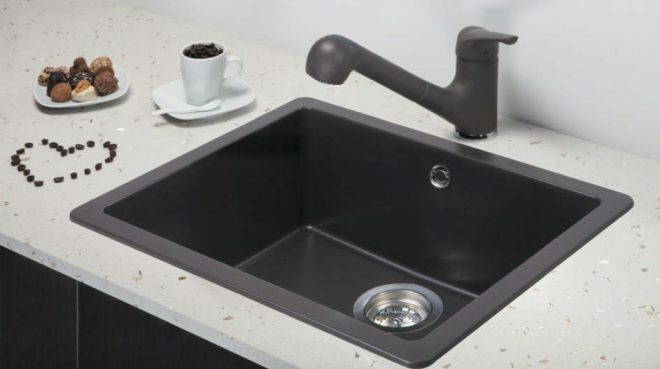
Nuances of care
Numerous reviews of consumers who have already installed a stone sink in their kitchens indicate that such a product does not need special care, but still you need to know some of the nuances. The surface of the material can suffer from various mechanical forces, for example, the fall of a heavy object causes chips and cracks. Such defects are difficult to repair, in some cases it is necessary to change the shell.
It is undesirable to install hot objects on stone products. A kettle with water heated to 80 degrees can cause stains. Clean the surface with soft sponges without abrasive substances, as such particles can lead to scratches on the product. A solution of concentrated acid and bleach is considered detrimental to the stone. Do not break the tightness of the joints during operation, this causes mold at the joints and can lead to damage to the wooden tabletop.
average rating 0 / 5. Number of ratings: 0
No ratings yet. Be the first to rate.


